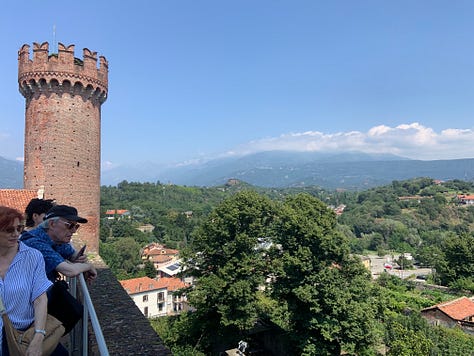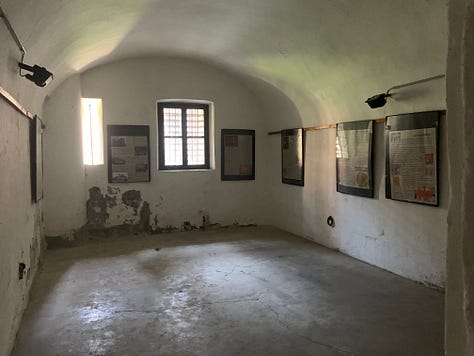Once Upon a Time, a Brave Count Built a Fortress
In a land where knights once roamed, the whispers of an ancient fortress still tell tales of bravery, mystery, and a tragic fate. I'll tell you the enchanting story of Ivrea's castle today.
There is a city in Piedmont, Italy. Small, nice, ancient. Imagine that it was created in the same place in the 5th century BC, before all of today's big and famous metropolises of Northern Italy. This city is called Ivrea.
You just read about it in my article: Ideal City Realized By Olivetti Family In Ivrea
Today many recognize this town for its castle with 4 red towers. Castle of Four Towers or Castle of Red Towers.
This castle was missing from my “collection” because it was closed. It is impossible to enter the city's closed buildings because the authorities can catch you. There's no pleasure in getting a nice fine to pay. So while I'm moderately adventurous in places where I can't be caught, in cities it's much wiser to stick to the community rules.
A week ago, a student said to me during class: did you know that the castle of Ivrea has been reopened for visits? From July 20.
I couldn't miss it and went to visit it at the first opportunity. (it’s open on weekends for two visits in the morning and two in the afternoon).
Why and where castles were built
As you know, castles could have various purposes:
they were used for defense (the most antique),
they were residential,
and finally “fake” castles, just for the pleasure of the lord (like Neuschwanstein Castle in Germany).
This castle was born as a fortification and for this reason, it has preserved some interesting for us parts to understand how our ancestors defended themselves.
The city today as always is located on a very important crossroads, here arrive the roads that lead to the main passes of Gran San Bernardo, Piccolo San Bernardo, Valchiusella, but also those that lead to Turin, Milan, and Vercelli. Up to Biella it is about thirty kilometers. Here is the importance of this place.
Amadeus VI of Savoy, the Green Count
The fortress was built by order of Amadeus VI of Savoy, known as the Green Count. Orphaned by both parents when he was not yet 10 years old, the young man devoted himself to military training, was a great lover of tournaments and probably at that time chose green as his distinctive color. At the time, color was an indispensable sign of a knight. Amadeus also had his troops dressed in green, and even the furnishings of his homes were green.
I found this video on YouTube so that we all can have an idea.
Amadeus was a valiant fighter and spent his whole life in wars.
In the middle of the 14th century, Green Count was busy fighting his relatives (Savoy Acaia) to obtain their properties. Therefore, he built a castle in Ivrea which they say is very similar to the one that Philip of Savoy Acaia (his enemy) had built a little earlier in Fossano (1324), not too far from there (I will go and check it soon).
Amadeus kept his cousin imprisoned. Philip's stepmother complained about him than and that was enough for Amadeus to condemn and drown him on December 21, 1368, in the lake of Avignano.
How castles were built
About this castle, we know incredible details. I want to quote it:
To build the castle, 507,625 bricks, 11,000 curved roof tiles, 3,653 stone carts, 6,210 novenes of lime, 216 iron pails to carry the lime, 10,000 flexible cords for the scaffolding. Also 40 dozen boards, 947 pounds of iron, 400 pieces of metal for the foundation of the roof gutter, 162 shovels and iron hoes were required. For transportation, 246 cows and just as many animal-drawn carts were used.
On certain days more than a thousand people worked there (Ivrea had around 3,500 inhabitants) with qualified workers coming from Vercelli, Milan and Geneva.
We know even the name of the master builder from Vercelli: Antonio Cognon.
First, the towers were built (1357-61),










Then the walls with a walkway and swallowtail battlements were added. In the first photo, you can see the projecting apparatus, supported by stone modillions, necessary for the patrol path (1363-70),
and finally, they built the moat (1384-93).
The main entrance was protected by a ravelin, a building outside the walls, the first frontier to be protected before the enemy could conquer the entrance that was further protected by a drawbridge, which no longer exists today.
Curiously, the ravelin was not meant to be a strong construction so that the enemy, once inside, could not use it against the castle's defenders. Imagine how it was: they enter that closed space, the drawbridge goes up, and the moat blocks the advancement.
I have seen similar constructions in cities of Greek origin (Paestum, Pompeii) which had parts protruding outside (but not buildings like in the castles) the walls to the right of the enemy: The soldiers had the shield in their left hand and their right side was exposed to blows from above by the defenders.
In the courtyard, you can still see the well and the icehouse (diameter of 6 m and depth of 4 m).









The last curiosity is about the four towers of the castle of Ivrea. They say, the towers are four, but you can see only 3 of them. Why?
The keep tower of the castle was used as a powder magazine in the 17th century. One day, lightning struck the tower and it exploded. The tragedy was immense. The tower contained 800 barrels of gunpowder. The blast and ensuing fire killed 50–80 persons and caused the ruin of over a hundred houses. The tower was repaired, but not rebuilt, and remains a truncated tower.
From that incident until 1970 the castle was used as a prison.
Would you like to read about more castles I have explored? Find a search at the top of this page and write “castle”. I have about 20 articles about different castles in this newsletter.
Did you enjoy this article? I would be very grateful if you click on the button ⬇︎ and share it with your friends.
Write me if you have questions, and I’ll be happy to answer.
Sponsored Content
Thank you to this week’s sponsor for keeping this letter free for everyone
Learn how to get your local business ranked #1 on Google






